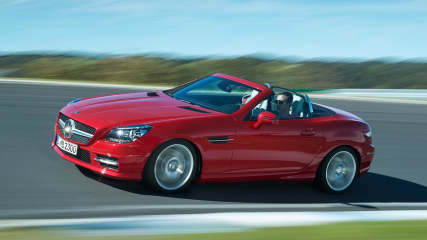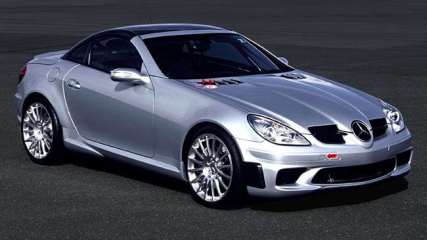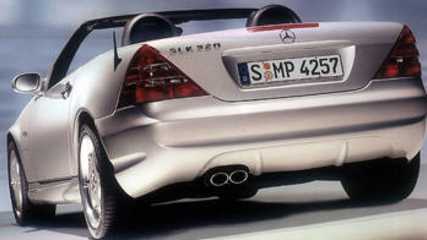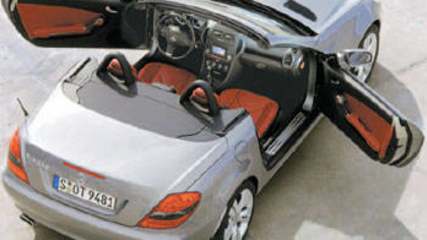Mercedes-Benz SLK 2011 Review
By Stuart Martin · 07 Mar 2011
The heat is on to get younger - and young at heart - owners into the new Mercedes-Benz SLK. Droptop sportscar driving fun all year round is the aim for of the third incarnation of the Mercedes-Benz two seater.The new hard-topped convertible has been endowed with the styling cues of the SLS AMG and the more recent CLS, as well as more efficient BlueEfficiency powerplants - two-turbo four-cylinders and a petrol V6, claiming up to 25 per cent better fuel economy.Australian SLK buyers will be offered the SLK 200, 250 (in lieu of the 300) and 350 models with only the seven-speed automatic when the model line-up arrives in the third quarter, but a diesel model offered in Europe is unlikely to make it here.What will make it here is the next AMG model, but details on the high-performance model's engine choice and other details are yet to be finalised.VALUEPricing is not yet set but Mercedes-Benz says the prices announced in Melbourne at the Australian International Motor Show mid-year will be close to the $92,000 starting price of the current model, with extra features to more than off-set any small increase.The range kicks off with the SLK 200 and SLK 250, both powered by the 1.8-litre direct-injection turbocharged four-cylinder; the 200 delivers 135kW and 270Nm; the 250's outputs from the same engine jump to 150kW and 310Nm .The SLK 200 claims 6.1 litres of premium unleaded per 100km and a 0-100km/h time of seven seconds. The SLK 250's thirst is 0.1 l/100km more, but the sprint time drops to 6.6 sconds.The 3.5-litre V6 engine in the SLK 350 - also seen in the new C-Class (on which the SLK is based) but not on the Oz-bound list - generates 225 kW and 370Nm, claiming the sprint to 100km/h is completed in 5.6 seconds. The V6, which claims fuel use of 7.1 litres per 100km, has been revamped to use third-generation direct injection and piezo injectors.Among the features list is the stop-start fuel saving system, Bluetooth phone and music link, leather-wrapped steering wheel, leather seat trim, seat heaters, trip computer, centre infotainment satnav display, LED running lights, the Airscarf heaters and a veratile (if small) boot with a reversible floor.The new SLK also has three suspension set-ups - standard steel-spring suspension, a sports-tuned version of the conventional system or the Dynamic Handling option, which adds the Sports button to sharpen up the chassis with electronically-controlled dampers.TECHNOLOGYThe SLK range now features stop-start as standard, appeasing the greenie conscience a little, but the most obvious hi-tech feature is the clever roof.Anyone who likes transition spectacle lenses will love the new world premiere (optional) Magic Sky Control roof, which transforms from transparent to heavily tinted at the touch of a button.The glass pane of the roof panel is altered by electricity - the particles are positioned to allow light through, until the voltage drops, when the particles re-align and partially block the light.The Dynamic Handling package includes the company's Direct-Steer variable-ratio system and the torque vectoring brake system, which brakes the inside rear wheel on corner entry to help the car turn in.DESIGNThe SLK has been given the new family nose, with the long bonnet, rear-set cabin and abbreviated rump all combing to complete an aesthetically-pleasing package, roof up or down.The company cites its iconic 1950s 190 SL, the new CLS and the SLS AMG all as styling influences. The bonnet and front wings are made of aluminium, but use of composite materials in the rear and lightweight steel, the body remains rigid but 13kg lighter than its predecessor.The interior oozes ergonomic character and quality, thanks to materials used - more SLS cues can be found, with the four round, galvanised air outlets.SAFETYAs you'd expect there's no shortage of safety technology - active head restraints, adaptive headlights, tyre pressure warning system and day-time running lights.There are dual front airbags, including a head airbag for lateral protection in the head impact area, as well as a side thorax airbag in the seat backrest.Added to the SLK's list is the drowsiness detection system Attention Assist, PreSafe and PreSafe Brake - which can hit the brakes autonomously if the detects a rear-end collision is imminent.The SLK can also have Distronic Plus active cruise control, the Intelligent Lights and Speed Limit Assist, which spots speed limit signs using a windscreen-mounted camera.DRIVING The tight, twisty and mountainous roads of Tenerife gave the SLK plenty of scope to shine and in some ways it did.The small turbo four powerplant in the SLK 250 sampled first makes all the right sort of noises, thanks to a "sound generator" that enhances the powerplant sound track, particularly the intake noise. The extra plumbing works, but the powerplant feels a little hesitant to get into its stride coming out of tight hairpins.The ride quality in both the base and electronically-damped cars is very good - even on the steep, frost-bitten sealed goat tracks - delivering decent body control as well, but some more accuracy and feel to the steering wouldn't go astray.The 250 and the seven-speed auto seem a good team, with downchange blips when the transmission's sport mode is engaged, although the ratio change could be snappier - it is being touted as a sportscar after all.The V6 powerplant doesn't need fancy plumbing to make nice noises, delivering deceptively quick progress, although it felt a little light on low-down torque. The seven-speed auto tacked on the back of the V6 had "issues", defaulting from the manual change mode using the paddles to the full-auto Economy mode - on a couple of the V6 cars.Mercedes-Benz staffers suggested heat and altitude on a spirited hillclimb drive might have initiated a protection mode.The aerodynamic performance of air deflectors with the roof down was effective, which meant little in the way of cabin buffeting, even well above normal highway speeds; the heated seats and the Airscarf neck vents kept the sub-10 deg C ambient temperature at bay.VERDICTAs a year-round proposition, the SLK - in either guise - is a capable all-rounder, but drivers looking for a scalpel to carve corners will be looking elsewhere in Stuttgart.Mercedes-Benz SLK-Class.Price: from around $92,000.Engine: 1.8-litre turbocharged direct-injection four-cylinder, 3.5-litre direct-injection V6.Transmission: seven-speed automatic, rear-wheel drive.Power: 135kW, 150kW; 225kW.Torque: 270Nm, 310Nm; 370Nm.Performance (seconds 0-100km/h, top speed): 7.0, 6.6, 5.6; 237km/h, 243km/h, 250km/h (governed).Fuel consumption (litres/100km): 6.1, 6.2, 7.1, tank 60 litres.Emissions (g/km): 142, 144, 167.Suspension: independent, coil springs, gas-pressure shock absorbers, stabiliser bar (front); multi-link independent, coil springs, gas-pressure shock absorbers, stabiliser.Brakes: four-wheel discs, front venntilated discs, with anti-lock, stability control systems.Dimensions: length 4134mm, width 1810mm, height 1301mm, wheelbase 2430mm, track fr/rr 1559/1565mm, cargo volume 335 (roof up)/225 (open-top) litres, weight 1470-1540kg.Wheels: 16in (17 in on 250 & 350).









